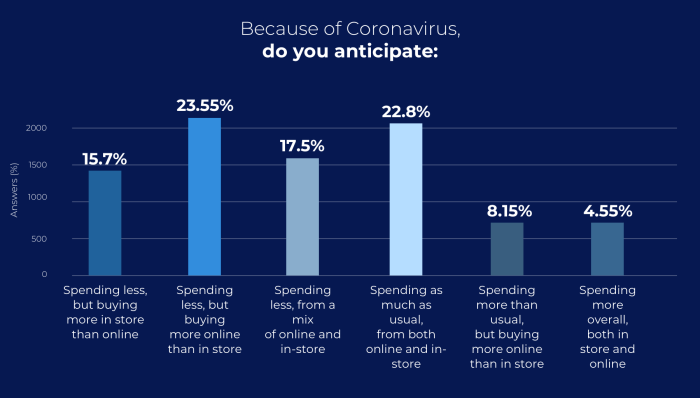Exploring the evolution of consumer behavior in the wake of the pandemic, this discussion delves into the shifting landscape of online shopping and the emerging trends that are reshaping the ecommerce industry. From changes in purchasing habits to the integration of cutting-edge technologies, this narrative uncovers the key factors driving consumer preferences in a post-pandemic world.
As we delve deeper into the impact of the pandemic on ecommerce and the innovative strategies businesses are adopting to meet evolving consumer demands, a compelling story unfolds before us, offering insights into the future of online shopping.
Impact of the Pandemic on Ecommerce

The COVID-19 pandemic has significantly altered consumer behavior, leading to a surge in online shopping as people adapted to the new normal of social distancing and stay-at-home orders. This shift towards e-commerce has had a lasting impact on how consumers make purchases.
Changes in Purchasing Habits
- Increased Online Shopping: With brick-and-mortar stores closed or operating with restrictions, consumers turned to online platforms to fulfill their shopping needs.
- Rise of Contactless Delivery: The preference for contactless delivery options grew as people prioritized safety and convenience.
- Emphasis on Essentials: Consumers focused more on purchasing essential items like groceries, personal care products, and home goods online.
- Decline in Impulse Buying: With economic uncertainty, impulse purchases decreased as consumers became more mindful of their spending.
Role of Safety Concerns
Safety concerns played a crucial role in driving consumers towards online shopping post-pandemic. The fear of contracting the virus in crowded spaces pushed individuals to prioritize their health and well-being. E-commerce provided a safer alternative for shopping, allowing customers to shop from the comfort and safety of their homes.
As a result, the convenience and safety offered by online shopping have become key factors influencing consumer behavior in the post-pandemic era.
Adoption of New Technologies in Ecommerce

In the ever-evolving landscape of ecommerce, businesses have been quick to adopt new technologies to meet the changing demands of consumers. From AI and machine learning to virtual reality and augmented reality, these advancements have revolutionized the online shopping experience.
Integration of AI and Machine Learning
AI and machine learning have been instrumental in enhancing the online shopping experience by personalizing product recommendations, improving search functionalities, and streamlining the overall shopping process. These technologies analyze consumer behavior patterns to provide tailored suggestions, leading to higher customer satisfaction and increased sales.
Use of Virtual Reality and Augmented Reality
Virtual reality (VR) and augmented reality (AR) have transformed the consumer journey by allowing shoppers to virtually experience products before making a purchase. Whether trying on clothes through AR fitting rooms or visualizing furniture in their homes with VR simulations, these technologies bridge the gap between online and in-store shopping, offering a more immersive and interactive experience.
Comparison of Traditional vs. Newer Technologies
The adoption of newer technologies post-pandemic has significantly improved the online shopping experience compared to traditional methods. While traditional online shopping relied on static product images and descriptions, newer technologies provide a more engaging and personalized shopping experience, ultimately increasing customer satisfaction and loyalty.
Sustainable Practices in Ecommerce Post-Pandemic
In the wake of the pandemic, sustainable practices in ecommerce have gained significant importance as consumers are increasingly conscious of the environmental impact of their purchasing decisions. Ecommerce businesses are now focusing on implementing eco-friendly initiatives to meet the growing demand for sustainability
Implementation of Eco-Friendly Practices
- Utilizing recyclable and biodegradable packaging materials to reduce waste and environmental footprint.
- Implementing energy-efficient practices in warehouses and fulfillment centers to minimize carbon emissions.
- Partnering with eco-conscious suppliers and manufacturers to source sustainable products.
Successful Sustainability Initiatives in Ecommerce
- Amazon's Climate Pledge: Committing to be net-zero carbon by 2040 and investing in renewable energy initiatives.
- Patagonia's Worn Wear Program: Encouraging customers to repair and recycle clothing to promote a circular economy.
- Loop's Reusable Packaging: Offering reusable containers for products, reducing single-use packaging waste.
Personalization and Customer Experience
Personalization and customer experience play a crucial role in the success of ecommerce businesses, especially in the post-pandemic landscape. By tailoring offerings to individual customers, businesses can enhance their shopping experience and drive sales.
Importance of Personalized Recommendations
Personalized recommendations are essential for increasing customer engagement and loyalty. By analyzing customer data such as browsing history, purchase behavior, and preferences, businesses can offer relevant products or services that match the individual needs of each customer.
Leveraging Data Analytics for Personalization
- Data analytics tools allow businesses to gather valuable insights into customer behavior, trends, and patterns. By leveraging this data, companies can create personalized marketing campaigns, recommend products, and tailor promotions to meet the specific needs of their customers.
- Through machine learning algorithms, businesses can predict customer preferences and behavior, enabling them to provide a more personalized shopping experience. This leads to increased customer satisfaction and repeat purchases.
Role of Customer Reviews and Feedback
Customer reviews and feedback are integral to shaping the online shopping experience. Positive reviews can build trust and credibility for a business, while negative feedback provides valuable insights for improvement. By actively listening to customer feedback and addressing their concerns, businesses can enhance customer satisfaction and loyalty.
Last Word
In conclusion, the journey through Ecommerce Trends in Post-Pandemic Consumer Behavior paints a vivid picture of the dynamic shifts and transformative practices that are revolutionizing the way we shop online. As sustainability, personalization, and technological advancements continue to shape the ecommerce landscape, one thing remains clear - adaptation is key in navigating the new normal of consumer behavior.
FAQ Guide
How has the pandemic affected consumer preferences in online shopping?
The pandemic has accelerated the shift towards online shopping as consumers prioritize safety and convenience.
What role does sustainability play in post-pandemic consumer decision-making?
Sustainability has become a key factor influencing consumer choices, leading to the rise of eco-friendly practices in ecommerce.
How are businesses leveraging data analytics to personalize customer experiences?
Businesses use data analytics to tailor offerings and provide personalized recommendations based on individual customer preferences.


